PS/SPS User Meeting
Zoom only
Zoom
Minutes of Meeting
The template for the minutes of meeting for the weekly PS & SPS users meeting can always be found using this link: https://codimd.web.cern.ch/0aHs5uqmSPuII76-SaaQdg
Please pre-fill them before the meeting with a summery of your activities!
PS-SPS Users Meeting for Week 31 held on August 1st, 2024
-
August 1st: User meeting on zoom only
-
September 4th: User meeting exceptionally on Wednesday on zoom only (05.09 is CERN holiday).
-
Updated user schedule v3.1.0.
-
Please get in contact, if you want to take one of the weeks without assigned main user - Tanja (tetiana.shulha@cern.ch) is collecting all requests.
-
Exchange Magnet H2 beamline: planned for 30.7.-1.8.2024:
No Beam to North Area from Tuesday morning until (expected) Thursday afternoon/evening.
News from the PS & SPS Physics Coordinator
E.B. Holzer, M.R. Jäkel
- 2024 injector schedule released EDMS 2872566
2024 approved LHC schedule EDMS 2872429
Proton Run 2024
- AD/ELENA Physics Stop Monday 02.12.2024
- SPS NA Physics Stop protons Thursday 31.10.2024
- PS EA Physics Stop protons Wednesday 27.11.2024
Ion Run 2024
- SPS NA Physics Start 4.11.2024 (maybe earlier if set-up is fast) - Stop Pb ions Monday 2.12.2024 (6h)
- NA : Week 45-47 high energy
- NA : Week 48 low energy (no LHC running)
- PS EA Physics Start 6.11.2024 (tbd) - Stop Pb ions Monday 2.12.2024 (6h)
- CHIMERA: 13.11-2.12
Reminder: Beam time exceeding the limits of 2 weeks PS beam time and 1 week SPS beam time per year need the approval of one of these CERN committees: SPSC, LHCC, DRDC, INTC, RB or IEFC. Consider joining a DRD collaboration, if you require more beam time.
News from the Facilities Operations Meeting (FOM) (E.B. Holzer)
Target intensities:
- August 2nd to 12th: 55 units on T10 (will required an estimated 75 to 85 units on T4) then reduce again to 21 units on T10 (about 42 units on T4)
- T2: 30 units
- T6: 30 units
Upcoming SPS MDs next weeks :
https://be-dep-ea.web.cern.ch/content/md-planning-north-area
Dedicated SPS MDs - if not anounced differently - are taking place from 8:00 to 18:00
- W31 Dedicated : 30.7 to 1.8 (shadow of magnet exchange)
- Dedicated: 30/7 → phase space manipulation with sextupoles & octupoles
- Dedicated: 31/7 → COLDEX
- Dedicated: 1/8 → noise 50Hz & BCMS optimization, Q22 studies
- No dedicated MDs for week 32, 33, 34
PS Machine Report (Bettina Mikulec)
Excellent availability of 97.1% this week.
Main issues:
- A few short faults from Linac4 and PSB
- For EAST_T9: recurrent issues on T09.BHZ031 starting last weekend; Firstline changed to the spare Tuesday morning; switched back to the normal Wednesday morning after adjustment of some threshold
- Wednesday morning sudden beam loss at start of acceleration; might have been an INCA/LSA issue, as problem disappeared once the INCA/LSA server had been reloaded (was out of memory)
- Sudden voltage drop on 400 kV line yesterday evening (lightning struck an RTE line between Romanel and CERN); had to restart quite some equipment
- PS was ready after ~20 minutes, but it took Linac4/PSB 45 minutes to recover
- Required a specialist intervention to restart the 10 MHz cavity 46
- Gap relay of 10 MHz cavity 96 broke during the night and will be exchanged now (1h beam stop)
Development:
- Delivered 200 ms spill to users in EAST_T9 Monday night
- Beam for COLDEX
- Very dense machine development program this week, also due to NA magnet exchange; needed to update MD cycles with phase change and PSB-to-PS energy matching corrections
SPS Machine Report (Giulia Papotti)
- no beam to NA for magnet exchange (Tue 30 8:00 - Thu 1 18:00, cooldown and intervention)
- time exchanged for MD slots
- intensity change Fri 2 starting at 9:30
- T2/T4/T6/T10 = 30/75-85/30/55
- issues with 50/100 Hz over the weekend being followed up
Safety (James Devine)
Issues this week:
- Dress code - long trousers are required everywhere that safety shoes are needed. This is all beam line zones.
- Helmets - Just because it is hot, doesn’t mean you don’t need your hard hat. Please ensure that you are wearing it at all times when walking round the test beam halls, even if it is to go to the break room.
- Late/Missing ISIEC submissions - we had several last minute submissions this week. If you want to ensure your experiment can start on time, submit your ISIEC as early as you can .
- Incomplete ISIEC submissions - If you are using chemical agents or gases (especially ones such as Isobutane) please declare them in your ISIEC form. We can only help you with what you declare, any surprises can lead to delays.
- Long term installations (Totem/CMS PPS, telescopes): If you are going to have a fixed installation in EHN1 or T09/T10 which will stay unchanged for most of the year, the safety office can send you an ISD (Initial Safety Declaration) to complete which allows us to give you a safety clearance for the entire run. Please send me an email if you are interested.
A reminder, the circulation routes in EHN1 are still modified on the Jura side by the M1 magnet.
The above is a summary, the formal rules for clothing and PPE can be found in EDMS 2193556 (clothing), EDMS 1223620 (PPE rules). You can find the ISIEC form here: https://ep-th-safety.web.cern.ch/isiec-safety-clearance (CERN login required, otherwise you won’t see the form)
nToF (Michael Bacak and Paolo M Milazzo)
Smoothing data taking in all experimental area.
EAR1: 63Cu(n,g)
EAR2: end of the campaign on Ar(n, g); on Monday 29.07 cool down of the activated Ar (8 h) and venting.
On 31.07 start of the measurement of the radioactive 88Zr(n, g) capture reaction. Auxiliary measurement with calibration sources and Au, Pb, C samples for normalization and evaluation of the background.
NEAR: Activation measurements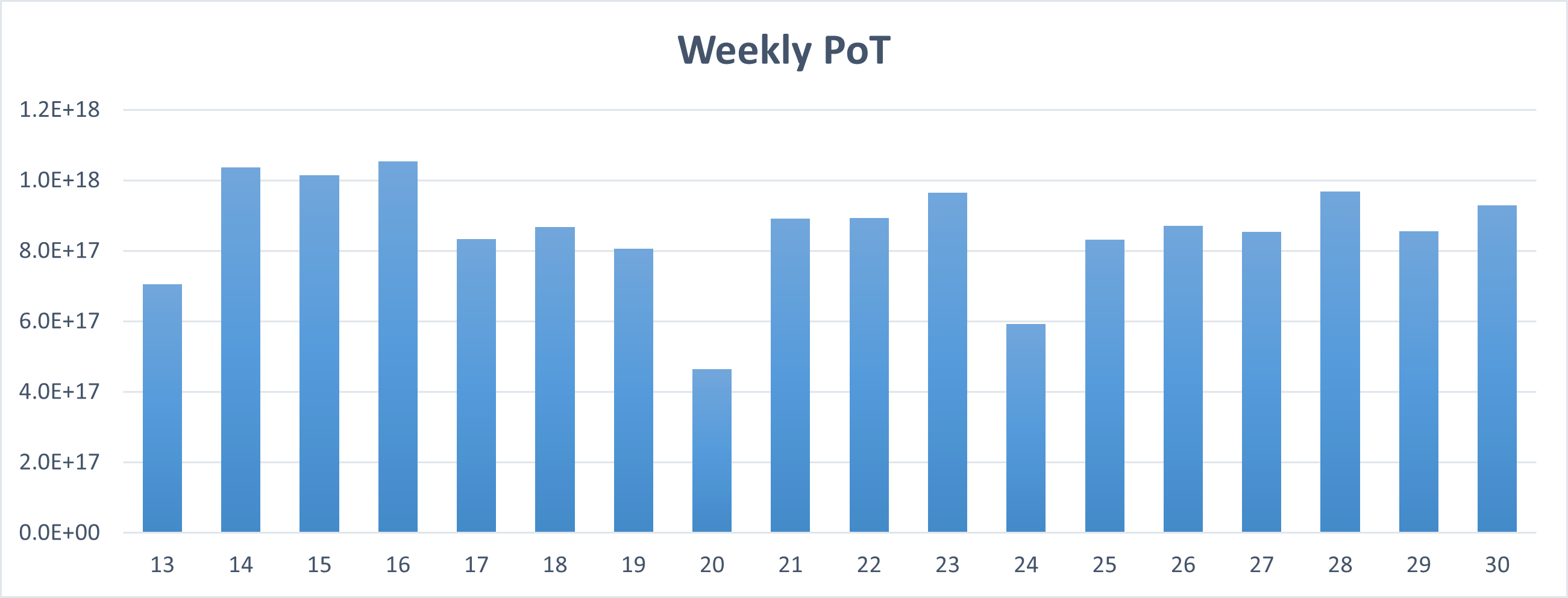
Protons received in standard conditions.
We kindly ask, if possible in the PS schedule, to receive more protons in the period 16.08-10.09. 88Zr has an half-life of 83 days. A more intense beam can compensate for the reduced amount of mass available.
East Area Beam Status (D. Banerjee)
General: The power converter gateway needed a reboot on Tuesday night. Caused a 5 minute beam stop for all east beams.
T09: Good operation. Recurrent issues with T09.BHZ031. EPC first line switched the power converter to the spare and it works better now.
T10: Smooth operation.
T11: Scaffolding installed in preparation for P349 installation and beam test.
East Area Users Tour de Table
T8 Main: IRRAD/CHARM (S. Fiore)
Very good week in T8, protons reached 2.84E16, and CHARM TID went up to 530 Gy - close to our record, speaking of olympics -
In IRRAD we finished with the cold irradiation ATLAS iTk strip modules and the INFN LHCb PMTs.
Continuing with long-term irradiation experiments (TE-MSC, EN-MME) and EP-DT-DD R&D (DRD3).
We will need again few steps with lower beam intensity ~4e11p/cm2 during the week.
In CHARM we didn’t move the rack, only modifications of setup in G0 (the low intensity position close to our patch panels)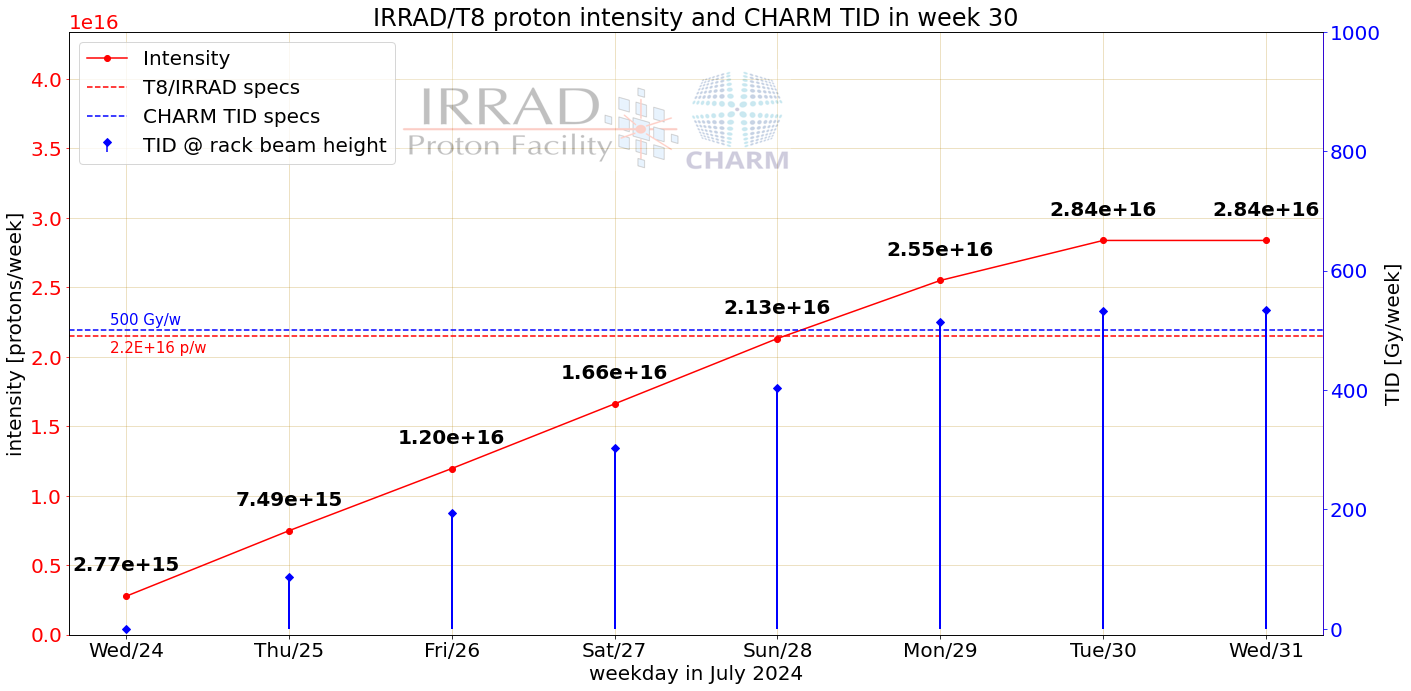
T9 Outgoing Main: CMS BRIL (Olena Karacheban)
Many thanks to the craning team for their help and efficiency!
Many thanks to Andre Rummler and Branislav Ristic for the telescope assembly and debugging.
And many thanks to operators and Dipanwita for requested beam files.
Great week of data taking, tested both types of sensors with different beams. For 15 GeV protind we found the configuration for oval beam, which covers all sensors homogeneously. A lot of data recorded with the telescope for offline analyses.
With 0.2 s spill stress tested the readout.

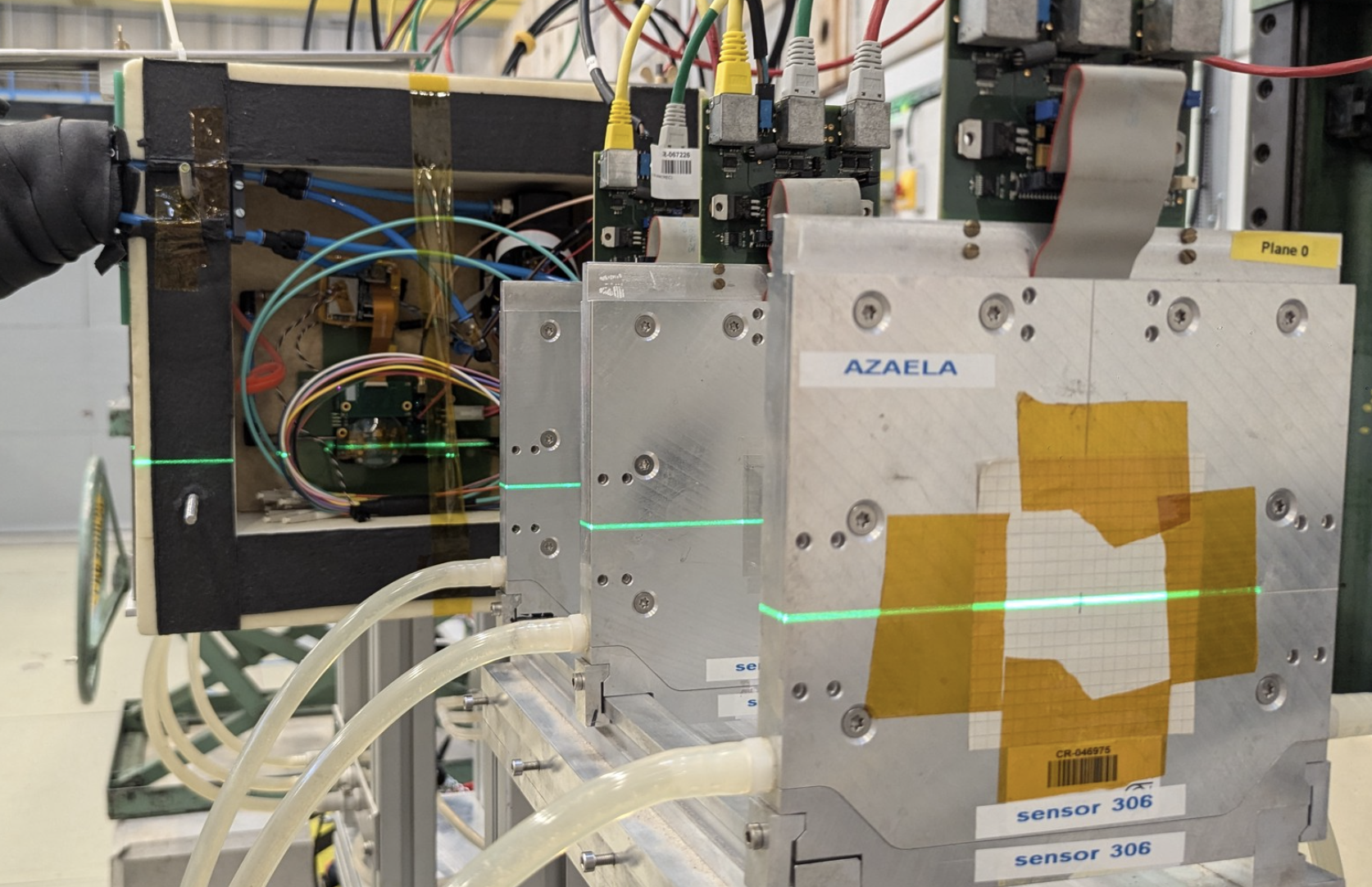
T9 Main: STCF ECAL&PID (Yunlong Zhang)
please see the slides
T10 Outgoing Main: BL4S (Seyma Esen)
-
Overall successful test beam for BL4S
-
We have completed pressure scans for different beams especially muon and momentum values which are directly related to what winner teams of this year want to measure when they come at CERN, in September.
-
With valuable suggestion of Maarten, we created muon beam always by using beam stopper in.
-
Maarten Van Djik compared the results of pressure scans for different HV values for PMT (before the increase in HV on the XCET040 PMT) and from Saturday night/morning (with the increased HV). It seems that XCET040 has recovered the performance from 2023:
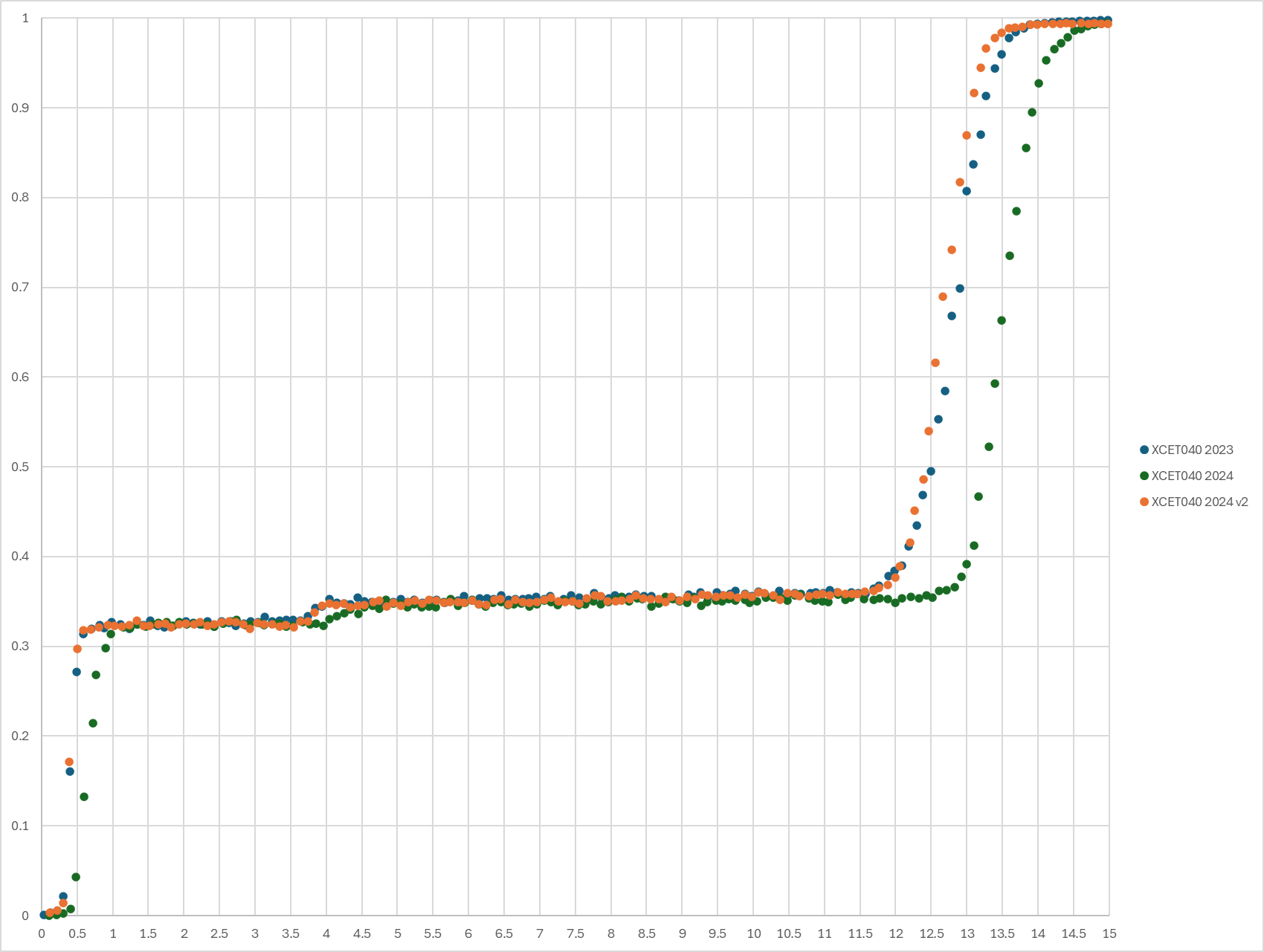
-
The issue with the XCET043 was that it was switched off, no idea how that could have happened. Since the gas was contaminated by environmental air, we have to cycle 4-5 times from 2 Bar to 0.1 Bar to “flush” the device.
-
Huge thanks to Maarten van Dijk for his support and advice! And also to Inaki Ortega Ruiz to help us a lot on debugging the issues related to XCET43. BL4S would not be possible without many helping hands, including BE-EA group; Aboubakr Ebn Rahmoun and all from infrastructure services; Jocelyn Tan and everybody else at BI; and E. Barbara Holzer.
-
Outlook: Testbeam in September (Weeks 37 & 38) where two winning teams perform their experiments at CERN => If you would like to meet the students (e.g. just to say ‘hello’ or to support them during the data analysis), please let us know. The students and us, we would be super grateful and happy to meet you!
T10 Main: ALICE ITS3(Paolo Martinengo)
Taking data, beam excellent, very efficient installation, thanks to Abou & C.
and outgoing users in T9 & T10
T10 Incoming Main: EIC BARREL ECAL (Week 32) (Jeongsu Bok)
- EIC Barrel ECal prototype(Pb/SciFi) of 32x9x15cm3 using PMT and SiPM will be tested with AstroPix silicon pixel chip(2x2cm2).
- For auxiliary detector, we will bring scintillators and optional SciFi hodoscope.
- We request two Cherenkov counters and two Delay Wire Chambers, DESY table (>80x80cm2 size), and additional adjustable table for auxiliary detector if possible.
- 0.5,1,2,3,4,5 GeV Muon, electron, pion beam would be great, and higher energy if purity is reasonably high.
- The program will start from calibration of calorimeter using muon beam, then we will study energy resolution and linearity using electron beam. We will also test energy deposit, dE/dx of AstroPix chip and a Pb/SciFi module with SiPM. In addition we will study beam position, angle dependence
Incoming No beam: P349 (Week 32) (Please Put Your Name Here)
North Area Beam Status (D. Banerjee)
Target Intensities
| T2 | T4 | T10 | T6 | from |
|---|---|---|---|---|
| 30 | 75-85 | 55 | 30 | 02.08. |
| 30 | 42 | 21 | 30 | 12.08. |
H2: Good operation. Exchange of quadrupole ongoing.
H4: Good operation.
H6: Good operation. Instrumentation reinstalled after e± run finished.
H8: Good operation.
M2: Good operation. The MS2 magnet for NA64mu is limited to 800A which is ok for the experiment due to cooling limits. TE-MSC will intervene at an agreed time with the user in the coming weeks to confirm the reason.
P42/K12: Good operation. Only one short downtime (15 min) due to a problem with the Bend 2 power supply control of K12. From tomorrow, 09:30, NA62 will be using the beam in dump mode with higher intensity on T10 (55 units).
AWAKE (Please Put Your Name Here)
HIRADMAT (Please Put Your Name Here)
North Area Users Tour de Table
P42-K12:
Main: NA62 (Joel Swallow)
- Smooth data-taking before technical stop. Thanks for delivery of generally very good quality beam.
- During Technical stop we have performed minor (but some importaint) maintenence tasks for our detectors.
- Ready now for beam back this afternoon.
- Data-taking plan for next week (Beam Dump data-taking):
- Re-start in standard “Kaon mode” and take at least 1 good run (~8h) of data. To be used for calibrations for dump runs.
- From ~9:30 Friday morning switch to deam dump mode [working with Johannes]:
- remove T10 target, close K12 TAXes (“Beam Dump Mode”)
- beam tuning to reach ~2x nominal intensity (equivelent of 55 units on T10).
- Magnets to be set for maximum sweaping to minimize background .
- 10 days of dump mode data-taking (ending 12 Aug).
- One “Kaon mode” run to be taken (planned for Tuesday 6th) again for calibrations.
- NA62 settings prepared for deam dump, including updated triggers to improve on minor DAQ difficulties from last year.
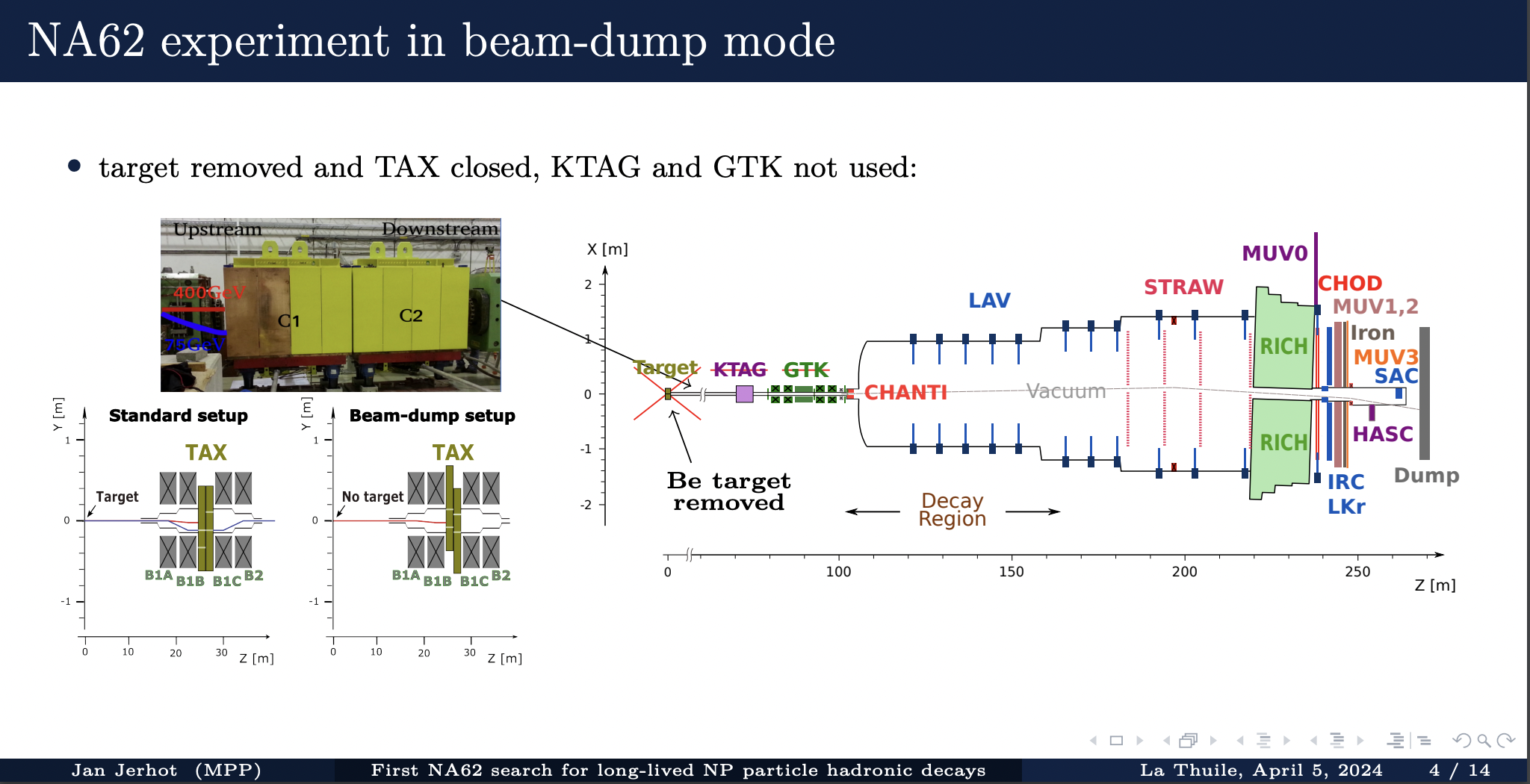
M2:
Main: NA64mu (Vladimir Poliakov)
We started used the beam at Friday afternoon after safety visit.
The commissioning and alignment of tracking detectors was done during weekend.
The muon calibration of all hadron calorimeters was performed at Monday. The beam and trigger tuning and final alignment of beam counters and tracking stations is ongoing.
H2:
Outgoing Main: NA61 SHINE (P. Podlaski, B. Maksiak)
Finished data taking last Tuesday morning
Summary:
- Collected 227.5M events (mostly from collisions of protons with prototype DUNE long target)
- Spill structure was optimal
- Successful data taking. Thank you very much for all help!
- Problems and interruptions:
- Beam position not stable when momenta of other beamlines in EHN1 change
- it would be very nice to find a solution (in cooperation with BE-EA)
- Occassional fluctuations of beam intensity
- It correlates very good with intensity measured on T2 target (see the plot)
- When preparing the run, problems with one of Delay Wire Chambers and CEDAR
- Power glitch on 9.07 that turned off all our electrical equipment. Fortunately, no impact on neither the data taking nor our equipment.
- False fire alarm on 24.07
- Some problems with TPC electronics cooling. Interventions of EN-CV fast and successful.
- Beam position not stable when momenta of other beamlines in EHN1 change
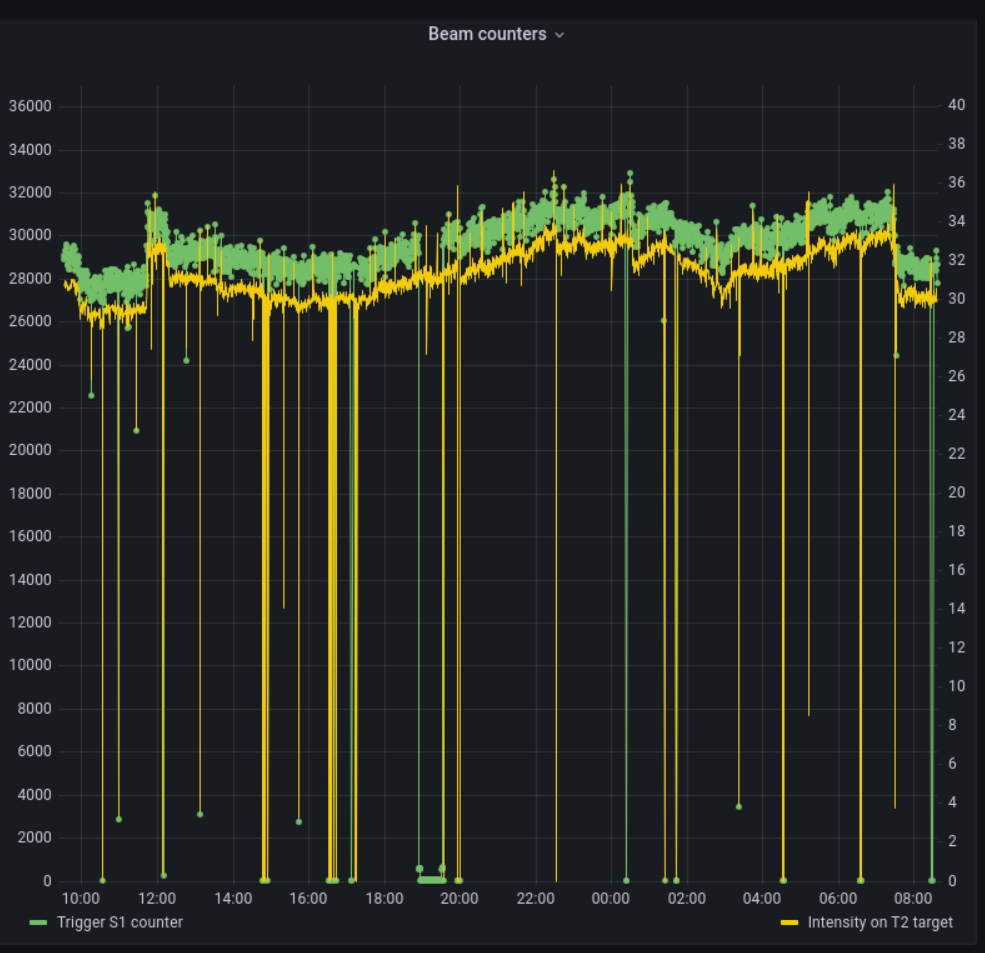
Main: CMS HGCAL (Chiara Amendola)
Detector consisting of
- 2 assemblies of 3-modules on copper plates (pic top left)
- 2 layers of scintillating tiles modules (pics bottom)
- front-end to back-end redout
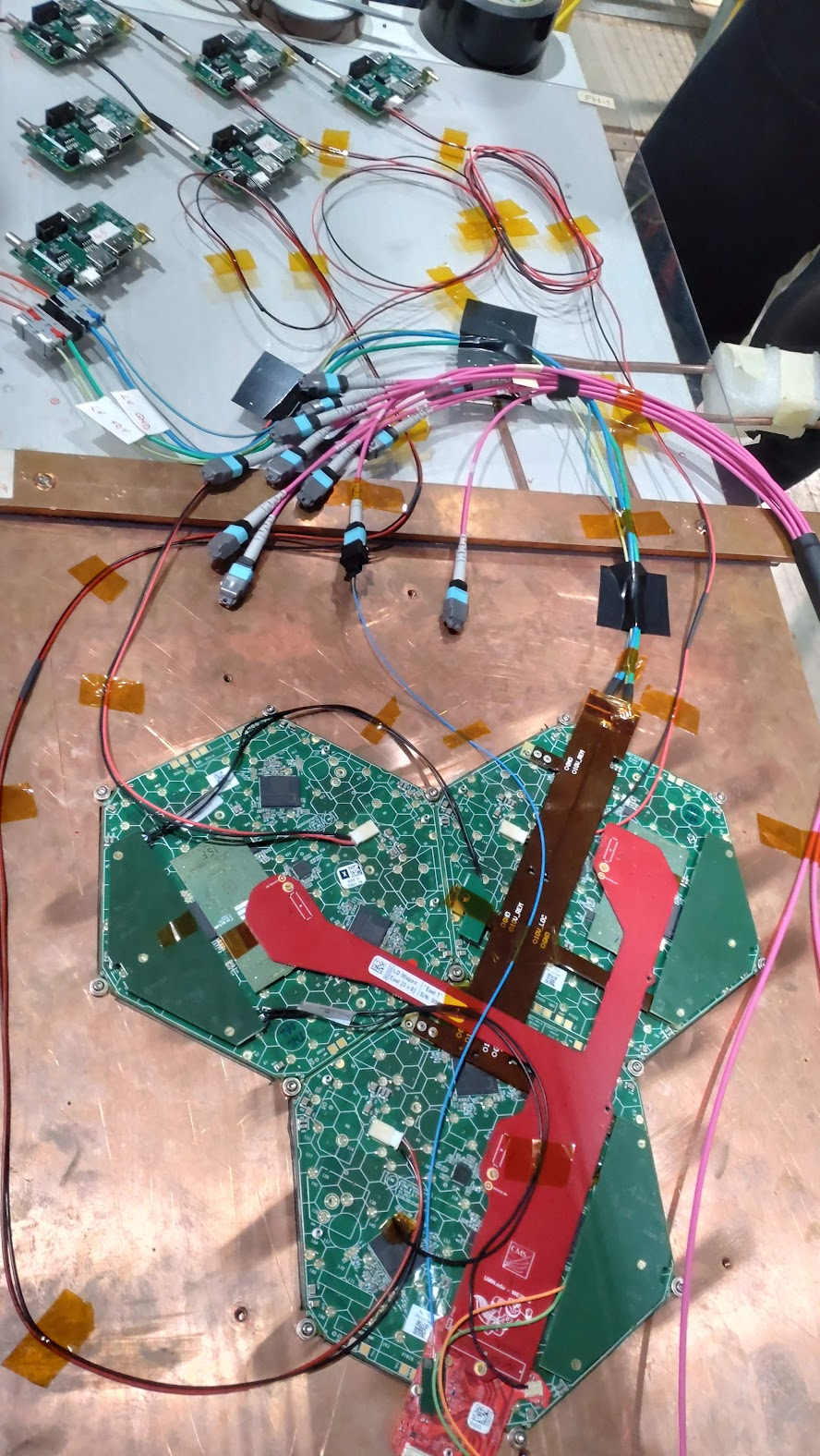 |
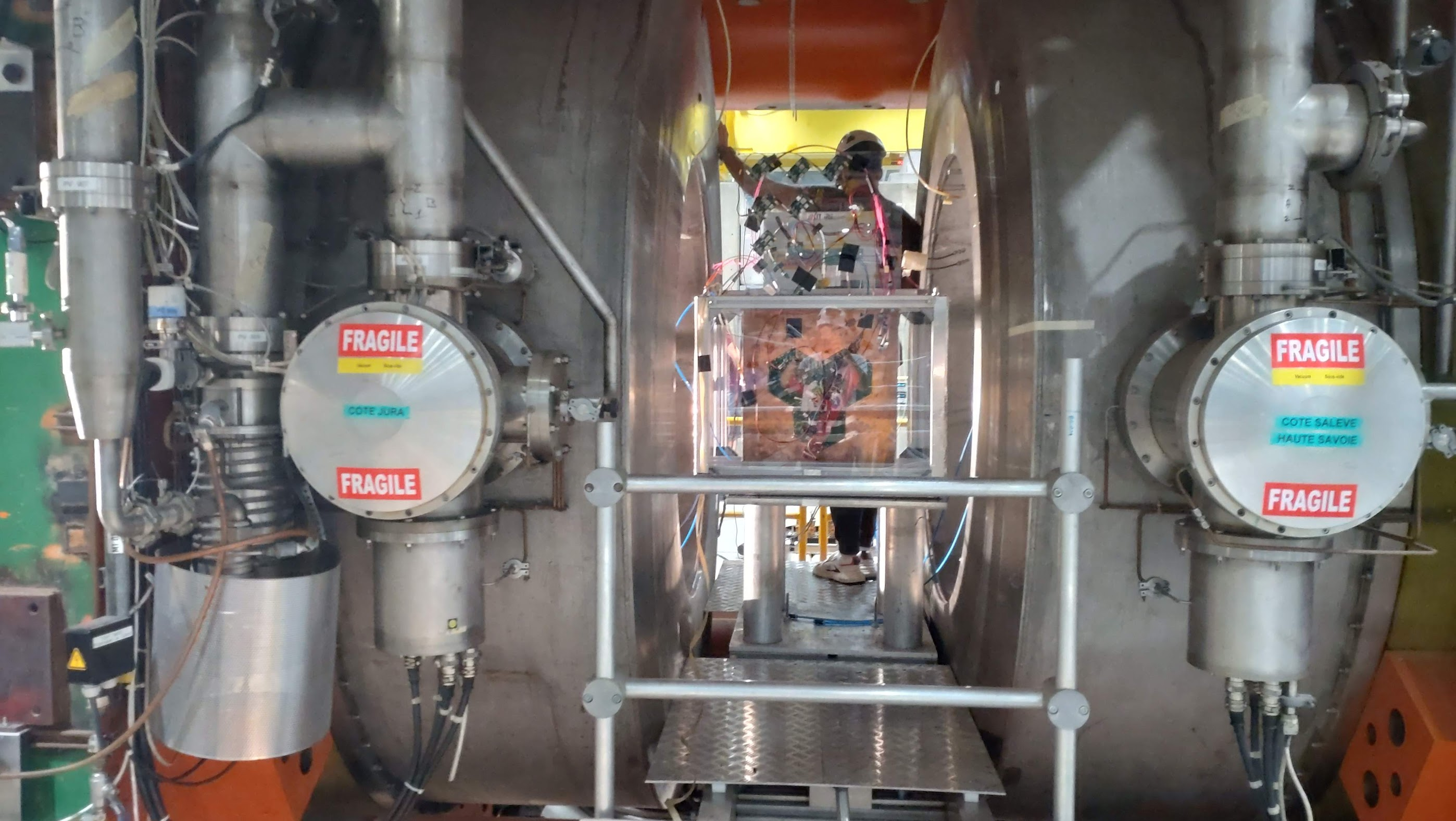 |
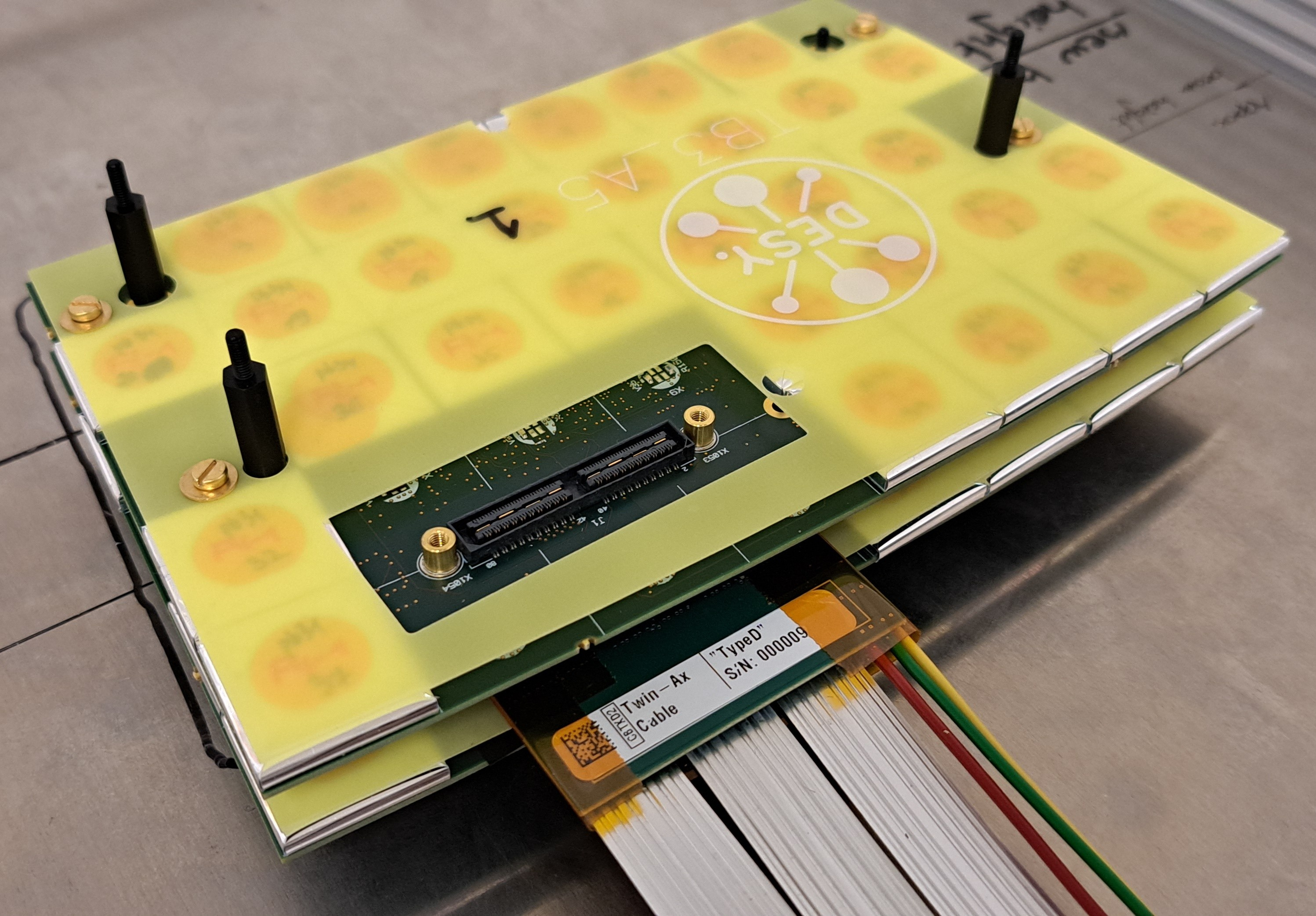 |
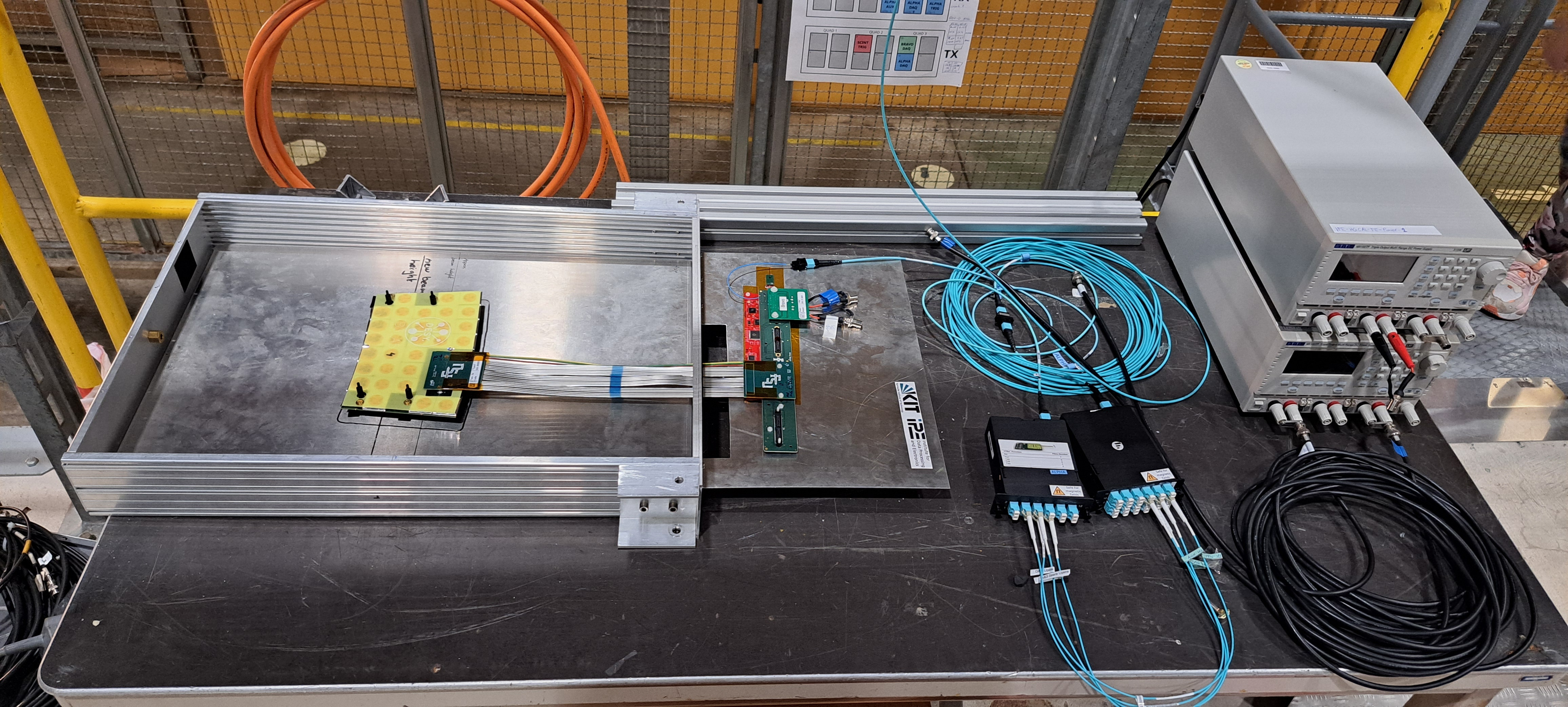 |
The installation is in M1 (pic top right), we had pedestal data-taking with Bon with stable back-end to front-end connection
- We have been installing since since 24/07 and testing the readout off-beam
- We are ready to take beam data, planning mainly on:
- e+/e- energy scans (20-300 GeV)
- muon runs (100 GeV)
- data will be taken with Bon/Boff
- As soon as we have beam we’ll be commissioning and tuning trigger delays
- As usual, thanks to the experts for the support in installation and safety, magnet operation, and preparation of the beamline
Incoming Main: CMS HF (Week 32)(Please Put Your Name Here)
H4:
Main: NP04 (Christos Touramanis)
Did various tests and developments over our off-beam week, all completed succesfully.
Ready to take data for 5 weeks!
Outgoing Main: DRD6 OREO (S. Carsi)
-
The week offered a extremely high duty cycle of the SPS, which allowed us to collect the data very fast, even if our beamtime ended one day in advance due to the MD of tuesday
-
During this week we continued the tests started in June in the T9 area, by testing OREO, a full prototype of an electromagnetic calorimeter based on oriented crystal, at higher energies, up to 200 GeV/c
-
The results look very promissing
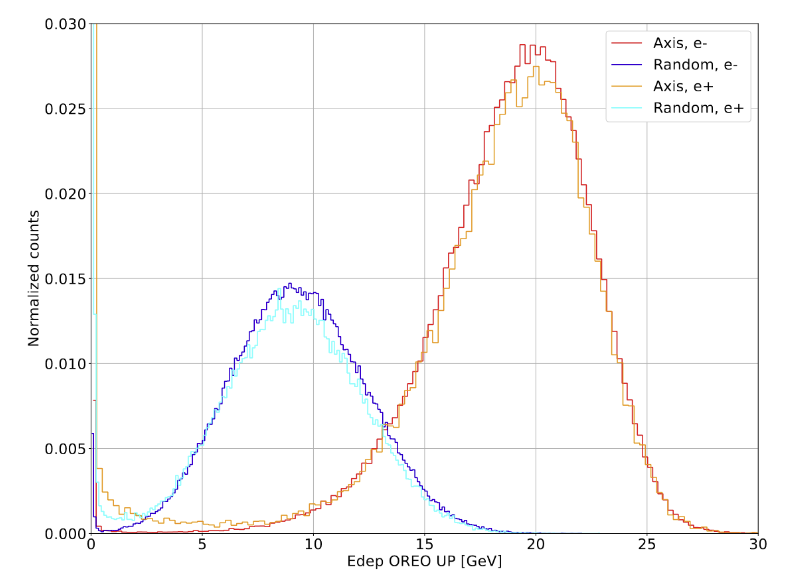
-
Every time we changed the beam momentum, NA61 experienced a beam displacement. We agreed to call them to stop their run when we were switching and calling them back once we were done
-
Special thanks to Sylvain for all the assistance inside the experimental area, to Nikos for the beam related questions and to all the CERN staff
H6:
Outgoing Main: EP FTS (Louis Roux)
We finished data taking last monday morning:
- MIP timing layer: study of different crystals (inorganic, quantum dots, etc.) under mixed hadron beam @ 120 GeV
- 2 prototypes of crystal calorimetry (Dual Readout & ChromoCalo): e−− + mixed hadrons
We have run once with muon beam for alignment, then mixed hadrons (10 ↦↦ 120 GeV) and electrons scans (from 10 ↦↦ 100 GeV).
The team is very happy with the quality of the beam (very high SPS duty cycle) and the data we’ve acquired during last week.
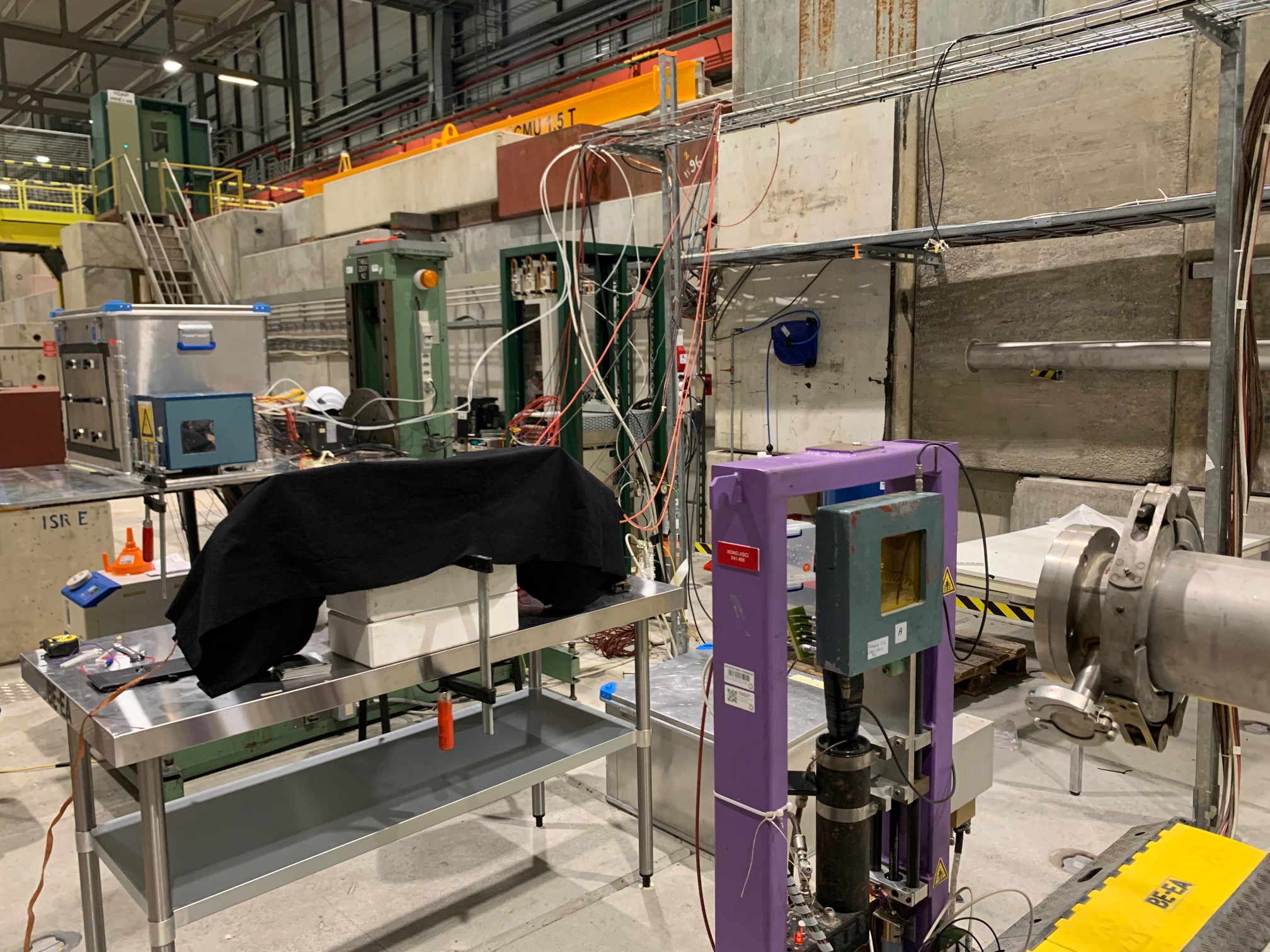
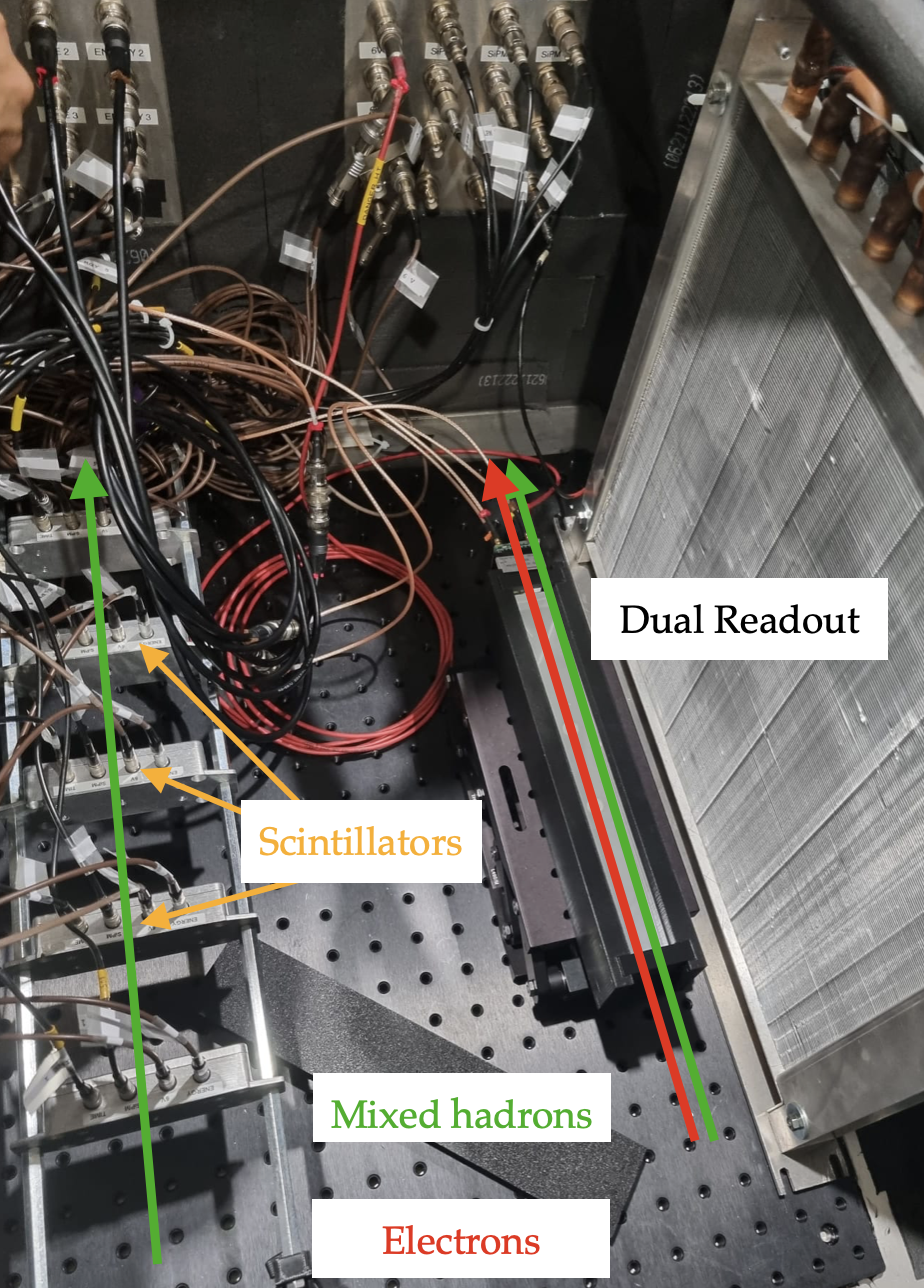
Left: Picture of the area with all the setups; Right: Dual Readout and MIPs timing layer setups
The EP-FTS team is very grateful to all the experts from SPS who made all of this possible!
Parallel: ATLAS ITK PIXEL (Andre Rummler)
We have still the same setup in the box (cold) since the last test beam. I topped up yesterday the Lauda chiller and put it back into operation. Telescope moved back into beam position. Currently trying to fix some communication issues and might do some test runs (without telescope; telescope stays off to protect it). Operation primarily remotely. Partial dismantling next week to allow HGTD data taking.
Main: EP PIXEL (Younes Otarid)
Characterization of H2M thinned samples (30um).
Telescope setup already commissioned and ready to be used.
Sample installation will happen today.
Data taking will start as soon as beam is back in the evening.
Friday morning, telescope will be momentarily deployed for beam profiling.
Continuous data taking expected from Friday afternoon on.
WITHDRAWN: Incoming Parallel: ATLAS BCM PRIME (Week 32) (Please Put Your Name Here)
Incoming Main: ATLAS HGTD (Week 32) (Stefano Manzoni - I’m sorry but I cant connect today)
Testbeam for the next two weeks aiming to test LGAD+ASIC (ALTIROC3) hybrids non-irradiated and irradiated.
- beam request: pions 120 Gev, 1-2 cm2, intensity ~10k particles/spill
- H6A material: TLU, Cold box, Aconite telescope, FEI4, Nitrogen
- Expected commissioning in 1 day, ISIEC submitted last week
H8:
Outgoing Main: ATLAS TRT (Anatoli Romaniouk)
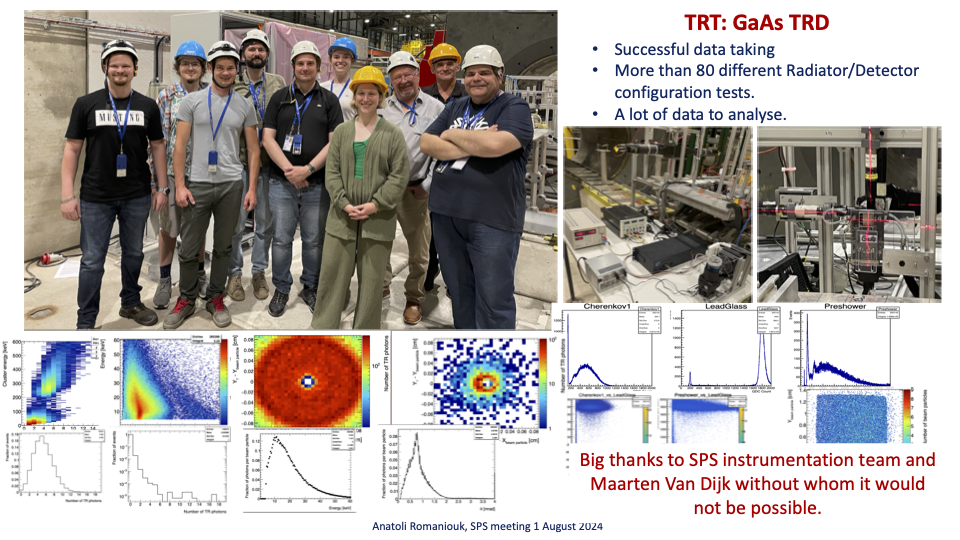
Taken a lot of data with maily hadron (~85%) and electron (~90%) beams.
Мanaged to complete the entire program despite the shortened beam time, Big thanks to all who helped us!
Parallel: LHCB (L. Martinazzoli)
Just started 1 week of testbeam for the VELO TimePix4 team.
VELO TimePix set-up:
- TimePix telescope + Si DUTs
- 2 MPC-PMTs for time reference
Ideal beam: “usual” mixed hadron beam, rate as high as possible (>= 1e6/spill), size ~cm
Not yet tuned the beam (of course) due to the technical stop. To be done this evening.
One note: the MCP-PMTs are necessary for meaningful data taking
Main: CMS PPS (F. Garcia)
The setup consists of two platforms: a gaseous triple GEM tracker and a trigger platform together with a set of irradiated Diamonds.
The recabling of the setup was carried out yesterday and today we will be ready to start with setting up of the system.
The beam characteristics were already shared with the beam physicst with a preference to small beam spot ~4-6 mm rms in both planes, pions with momenta 180 GeV/c and rate the maximum possible.
The physics program is very board and amoung the most impotant measurements are the bevavour of the CCE while illuminated with different LED diodes.
Incoming Main: QFIB (Week 32) (Suat Özkorucuklu)
QFib setup is already installed. DESY table is used. All cabling is done.
DAQ setup is on going. Safety Ispection at 4:30 PM
Incoming Parallel: DRD6 IDEA DRC (Week 32) (Gabriella Gaudio, Seungkyu Ha)
Week 32 is the first of 4 weeks of test for IDEA Dual Readout Calorimeter.
- Week 32: detector and DAQ setting up for both prototypes.
- Week 33 and 34: hadronic prototype from the Korean group (contact Hwidong Yoo)
- Week 35: hadronic prototype from the Italian group
Program of the week 32:
- installing ancillary detectors on the beam line (PPE 168); detectors test and acquisition
- finalization of prototypes and test
Details from Korean Team:
- The DRD6 DRC Korean Team has developed a new full-size detector for this experiment(30cm x 30cm x 2.5 M). The modules will be placed on a sapphire table, with the DAQ system installed just behind it. We will use square-type PMTs and an MCP-PMT.
Parasitic Users
H6: ATLAS MALTA (Please Put Your Name Here)
H8: STRAW TRACKER RD (Please Put Your Name Here)
H8: QFIB (Suat Özkorucuklu, Berkan Kaynak)
QFib will be ready and optimise beam requests once parasitic week is completed.
AoB
Minutes by the respective speakers, edited by E. B. Holzer, M. Jäkel, T. Shulha, and M. Schwinzerl